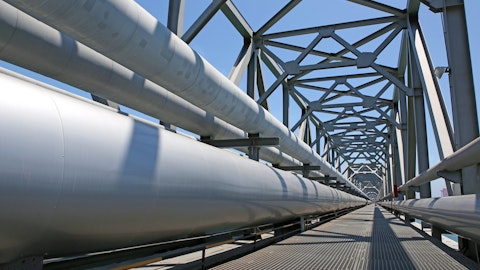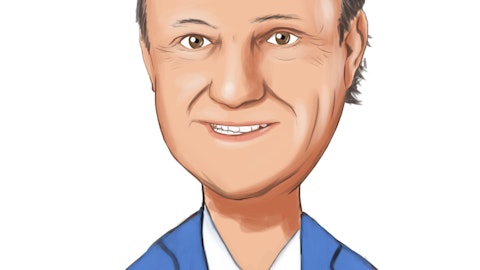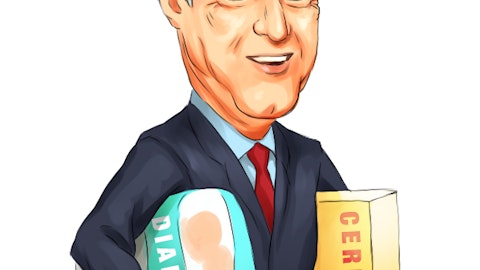Graham Corporation (NYSE:GHM) Q3 2023 Earnings Call Transcript February 6, 2023
Operator: Greetings. Welcome to Graham Corporation’s Third Quarter Fiscal Year 2023 Financial Results Conference Call. At this time, all participants are in a listen-only mode. A question-and-answer session will follow the formal presentation. Please note this conference is being recorded. I will now turn the conference over to Debbie Pawlowski, Investor Relations. Thank you. You may now begin.
Deborah Pawlowski: Thank you, Sherry, and good morning everyone. We certainly appreciate your time today and your interest in Graham Corporation. Here with me on the call are Dan Thoren, our President and CEO; and Chris Thome, our Chief Financial Officer. You should have a copy of the third quarter fiscal year 2023 financial results, which we released this morning and if not you can access the release as well as the slides that will accompany our conversation today on our website at ir.grahamcorp.com. Dan and Chris will provide their formal remarks, after which we will open the line for questions. If you would turn to Slide 2 in the deck, I’ll review the safe harbor statement. You should be aware that we may make some forward-looking statements during the formal discussions, as well as during the Q&A session.
These statements apply to future events that are subject to risks and uncertainties, as well as other factors that could cause actual results to differ materially from what is stated here today. These risks and uncertainties and other factors are provided in the earnings release, as well as with other documents filed by the company with the Securities and Exchange Commission. You can find those documents on our website or at sec.gov. During today’s call, we will also discuss some non-GAAP financial measure disclosures. We believe these will be useful in evaluating our performance. However, you should not consider the presentation of this additional information in isolation or as a substitute for results prepared in accordance with GAAP. We have provided reconciliation of non-GAAP measures with comparable GAAP measures in the tables that accompany today’s release and the slides.
So with that, if you would please advance to Slide 3, I’ll turn the call over to Dan to begin. Dan?
Dan Thoren: Thank you, Debbie, and good morning, everyone. Before I get started, I’d like to congratulate the Barber-Nichols team for making Glassdoor’s Best Small & Medium Places to Work list for 2023. They notably ranked tenth out of the Top 50 companies named. Our team and the culture at Barber-Nichols have created a cohesive and innovative environment that people enjoy, which is validated by rankings such as this. Throughout Graham Corporation, as we advance our strategy, I believe it’s important for our businesses that we keep our workforce highly engaged, that we provide a work environment in which all feel welcome and we strive to create opportunities for each to achieve the best of their abilities. I believe we accomplished this by providing our teams with the resources, inclusive culture, and professional development they need to be their best at addressing our customers’ requirements.
Now, on to our results for the quarter. Our third quarter results reflect improved execution and demonstrate continued steady progress as we increase our sales and improve our profitability. Chris will walk you through much of the details, but let me touch on some important highlights. We delivered $40 million in revenue achieved $0.03 per diluted share in earnings and $0.08 in adjusted earnings per share, and we ended the quarter with $294 million in backlog. Driving this was strong gross profit, improved gross margins, and continued cost discipline. In fact, we generated $2.2 million in adjusted EBITDA this quarter. Our solid results enabled us to raise our fiscal 2023 revenue guidance to be in the range of $145 million to $155 million and tighten our adjusted EBITDA range to be between $7.5 million and $8.5 million for the year.
We believe the quarter is a proof point along our path to reach our strategic long-term goals of $200 million in revenue and 10% to 15% adjusted EBITDA margin by fiscal 2027. Our successes with the U.S. Navy have resulted in a very robust backlog of defense business and we are continuing to strengthen our position in commercial aftermarket, while increasing our presence in the growing space industry. In fact, I will dive a little deeper into the backlog and long-term visibility and growth potential of Navy projects later this call. While orders in the quarter of $20 million were soft, we believe it was primarily due to timing and a reflection of the general ebb and flow of large projects being released. Our trailing 12-month orders of approximately $176 million and the 114% book-to-bill ratio are a better representation of our growth in future potential.
This is especially true given the large value of repeat orders we have received for critical U.S. Navy projects, which we believe validates our position as a key supplier for the defense industry. I should note that January order rates have started out strong, which is very encouraging. I’ll now turn the call over to Chris who will provide more details on the quarter and expectations for the remainder of the year. Chris?
Chris Thome: Thank you, Dan, and good morning, everyone. I will begin my presentation on Slide 4. As Dan mentioned, our third quarter performance was in-line with our expectations. We had record quarterly sales of 39.9 million, up 39% or 11.1 million over last year’s third quarter, and was driven by our defense, refining, aftermarket, and space markets. I would like to point out that this growth was all organic as both periods include a full quarter from Barber-Nichols. Sales to the defense market were up 5 million and represented 54% of total revenue. The increase over the prior year period reflects the achievement of project milestones, as well as improved execution. You may recall that last year’s third quarter included the impact of U.S. Navy first article project, labor and cost overruns, which impacted revenue, as well as margin.
As noted in our release today, we delivered an additional first article unit for critical U.S. Navy program during the quarter, bringing the total of first article units shipped to four this year. We are on schedule to ship the remaining first article units by the end of the second quarter in fiscal 2024. Base revenue increased 2 million versus the prior year and is being driven by newly awarded programs, which continue to ramp up and the relationships we have with many of the key commercial players in this growing industry. Additionally, during the quarter, we continued to see strong growth in the refining aftermarket, which was up 2.5 million or 64%. We are encouraged by this aftermarket demand as it oftentimes is a leading indicator of future capital investments by our customers.
Additionally, we are proactively working to drive aftermarket demand, which is a key strategic initiative for us. For the quarter, sales in the U.S. increased 34% and represented 83% of our sales, while international sales accounted for 17% of total sales and is 66% higher than one year ago. The mix of U.S. to international sales has shifted over the last couple of years given the growth in our Navy business, as well as the addition of Barber-Nichols, which sells primarily into the U.S. Gross profit and margin improved significantly over the prior year period, which was impacted by the labor and material cost overruns I just mentioned. Sequentially, gross profit improved 18% on a 5% increase in revenue, due to continued improvement in execution better pricing, as well as a better mix and increased volume.

Photo by Alex Mihis on Unsplash
SG&A expense for the third quarter, excluding intangible amortization was 5.3 million, up 12% or approximately 555,000. However, SG&A expense as a percentage of sales improved to 13.3%, compared with 16.4% in the comparable period in fiscal 2022. As we continue to maintain strong cost discipline while growing our top line. The net result of our growth in revenue and gross profit combined with strong cost discipline is shown on Slide 5. For the third quarter of fiscal 2023, net income was 368,000 or $0.03 per diluted share. On an adjusted basis, earnings per share was $0.08 per diluted share and adjusted EBITDA was 2.2 million. This was the third consecutive quarter of solid results as we have stabilized our business and improved execution. We continue to drive increased productivity through improved project management and accountability.
Turning to Slide 6, you can see our capitalization. Total debt at quarter-end was 14.2 million, compared with 19.1 million at the end of the second quarter. We paid down 5 million of debt during the quarter, which was funded by 9.3 million of cash flow from operations. I should point out that current quarter cash flow reflects 8 million of customer deposits received for materials related to larger defense contracts. Going forward, we expect our cash flow to be lumpy, due to the nature of these large contracts. Also noteworthy is that these debt payments and stronger EBITDA levels brought our bank leverage ratio down to 2.5x at December 31, and we are now back in compliance with the original terms of our credit agreement. This is one quarter ahead of schedule and is a direct result of the hard work of the Graham associates who continue to execute our strategic plan.
Capital expenditures for the quarter were 1.2 million, which brings the nine month total to 2.4 million. We continue to expect capital expenditures to be approximately 3 million to 4 million for fiscal 2023, which implies about 1 million in CapEx for the fourth quarter at the mid-point of the range. Going forward, we expect capital expenditures to be at an elevated level as we invest in our growth initiatives. We are focused on generating cash to reduce debt and are making investments in organic growth opportunities. We have instituted strong cash management throughout the organization, which includes actively managing working capital and operating expenses, while increasing oversight of capital expenditures to ensure a proper return on capital.
Turning to Slide 7. For the quarter, orders were soft, primarily due to the project timing. Despite that, our pipeline of opportunities remains robust. For the nine-month period, orders were 151.9 million, up 26% over the prior year. And our book-to-bill ratio was 133%. This includes a 47% increase in defense orders, a 141% increase in space orders, and a 33% increase in energy and chemical aftermarket orders. We believe that the repeat orders for critical U.S. Navy programs validates the investments we made over the last year, and our customers’ confidence in our execution. We also expect these repeat orders will be at higher margins through increased pricing and better execution. If you turn to Slide 8, you can see that orders drove an 8% increase in backlog from the third quarter last year and now sits at 294 million.
We believe 40% to 50% of this backlog will convert within the next 12 months and 20% to 30% is expected to convert the following 12 months. Most of the backlog expected to convert beyond 12 months is for the defense industry, primarily to the U.S. Navy. Defense now comprises 80% of our backlog and is significant and that it provides greater visibility and stability to our business. I’ll now turn the call back to Dan to speak to our longer-term strategy and in particular the opportunity with defense, as well as our outlook for the remainder of the year. Dan?
Dan Thoren: Thanks, Chris. Let’s turn to Slide 9. As you saw on the last slide, we have measurably increased our presence in the defense industry. The recent wins have grown our defense backlog to 234 million, which is 80% of total backlog. And I’ll remind you that more than half of our revenue in the quarter was from the defense industry. These long-term U.S. Navy contracts provide us longer-term visibility with revenue over several years and the repeat build process drives a solid recurring increasingly profitable revenue stream. Navy ship procurement spans over decades and our contracts are often 3 years to 5 years in duration. It’s worth reminding you that we are often the sole qualified supplier on orders with high barriers to entry for the competition to overcome.
Executing well, delivering to plan, and high quality helps ensure future orders. Once we win these opportunities, we work to expand our margin through improved efficiencies and supply chain management and improved pricing as we win future orders. Beyond the equipment we are currently supplying to the Navy, we see other potential revenue streams. There are for example opportunities for repair and maintenance revenue. And as we look further into the future, the next generation attack submarine design has begun and Graham has a role in that development program. Now, let’s turn to Slide 10. This is a bit of an eye chart, but it will help you understand the growth potential we have as it relates to planned projects. I’ll walk you through this. With the CVN Ford Class Carrier, there are two completed carriers and two currently under construction.
There are eight remaining builds planned with a timeline of one every four years. Our revenue per ship is approximately $40 million to $50 million. We estimate that over the remaining life of the program, including what we have in process, we have about 400 million in revenue potential. With the SSN Virginia Class Subs, there are 22 subs completed and eight are under construction. Over the next 25 plus years, there are 36 remaining builds planned at about two subs per year. We estimate our future revenue potential for this ship class is about $300 million. I should point out that we are typically building ahead of actual submarine funding with advanced funding as new design blocks are initiated. Finally, for the SSBN Columbia Class Subs, there is one under construction and 11 planned builds remaining.
The Navy is currently planning build one Columbia Class per year through 2035. Our per sub revenue is approximately $40 million with total future revenue potential of $400 million. Based on these projects and then rounding up for torpedo power & propulsion hardware that we provide, we estimate approximately $1 billion to $1.3 billion in total potential revenue over the next 30 years from projects with the Navy. The torpedo’s content and value is confidential as you might imagine and of course a number of torpedoes is subject to arsenal inventory plans. There’s a lot of excitement here at Graham Corporation regarding our many Navy projects and it does give us confidence regarding our strategic plan and goals. If you turn to the next slide, you can see our updated full-year guidance.
Overall, we did take our fiscal 2023 guidance up including bumping the revenue range up to 145 million to 155 million, sticking with a gross margin of about 16%, SG&A about 15% of sales, and adjusted EBITDA ranging between 7.5 million and 8.5 million. This implies an adjusted EBITDA margin of approximately 5% at the midpoint of the range, well short of our aspirational goals, but significantly above last year. We are making steady progress against our plan and expect that we will continue to do so over the next several years. Importantly, as Chris noted, we are strengthening our balance sheet, improving financial flexibility, and generating cash. This will help enable us to execute on our growth plans both organically, as well as with acquisitions.
With that operator, please open the phone lines and Chris and I will be happy to answer any investor questions.
See also 20 Best For-Profit Colleges in the US and 15 Most Undervalued Small-cap Stocks To Buy .
Q&A Session
Follow Graham Corp (NYSE:GHM)
Follow Graham Corp (NYSE:GHM)
Operator: Thank you. Our first question is from Theodore O’Neill with Litchfield Research. Please proceed.
Theodore O’Neill: Thank you very much and congratulations on the good quarter.
Dan Thoren: Thanks, Leo.
Theodore O’Neill: Yes. So, yes, it’s clear that orders are lumpy here and I want to talk about that for a minute. And if I look back over the last couple of years, fiscal 2020 was a desert and the orders have been, sort of ramping up 2021 and 2022. And if I do a trailing 12-month or a last four quarter, average, the curve keeps sloping upward. How much further upward is this going to slope up in your opinion?
Dan Thoren: Well, certainly one big thing that happened in that time frame was the acquisition of Barber-Nichols. And so that certainly helped make the thing trend up. We again, kind of long-term guidance that we had put out there, I mean by fiscal 2027, we want to be at the $200 million range. So, is it a smooth path there, is it a lumpy path there? Hard to tell at this point. But growth is something that we’re working pretty hard on getting into strategic programs like we’ve been getting into. Being much more aggressive on the commercial side of the business in the energy and petrochem side, as far as going after a lot of that aftermarket business all fits into this longer-term growth. So, I would say that it is expected to continue to grow and kind of towards that 200 million in 2027.
Theodore O’Neill: Okay. And in the refinery market, what are the dynamics there that are giving you confidence about the future business for you?
Dan Thoren: That market is kind of crazy. So, there’s certainly we’ve seen an uptick in aftermarket orders and those have remained strong here over the last year. In the past, those have been a precursor to more of the capital, the larger capital type equipment orders. We haven’t seen those pick up quite yet, but it’s interesting to watch the market and a lot of the press regarding that in all of the big profits that the oil companies are making. Refineries are running full-out. They’re just unbelievably hard pressed right now and the U.S. really hasn’t expanded our refining capacity for a while. So, at some point, we do expect that we’ll see some of the capital markets start to or the capital equipment orders start to turn on, but we just haven’t quite seen that yet.
Theodore O’Neill: Okay. That makes sense. Thanks very much.
Dan Thoren : Yes. Thanks, Theo.
Operator: Our next question is from Graham Mattison with Water Tower Research. Please proceed.
Graham Mattison: Hi. Good morning, everyone. Just to follow-up on Ted’s question around the aftermarket and the refining area. Can you give us you mentioned that you’re really putting a proactive effort to drive aftermarket sales. Can you talk a little bit about what gives you that confidence around those and what type of efforts you’d be employing there?
Dan Thoren: Yes, it’s so Graham Corporation had a very significant database of installations and they talked about like $1 billion of installed base that they’ve had over the many, many years that they’ve been working in these markets. And as we look at that installed base, we realize that we’re not as proactive in going back and following up with those prior customers to understand how the equipment is continuing to operate. Some of that equipment has met its lifetime. And it’s time to replace it and we just not have not been as aggressive with that as we could have been. So, building up our aftermarket team using the database of the base to really understand how old is that equipment, what would we recommend to the operators, as far as maintenance and replacement.




